MERCEDES-BENZ EQC SUV 2021 Owners Manual
Manufacturer: MERCEDES-BENZ, Model Year: 2021, Model line: EQC SUV, Model: MERCEDES-BENZ EQC SUV 2021Pages: 453, PDF Size: 8.68 MB
Page 171 of 453
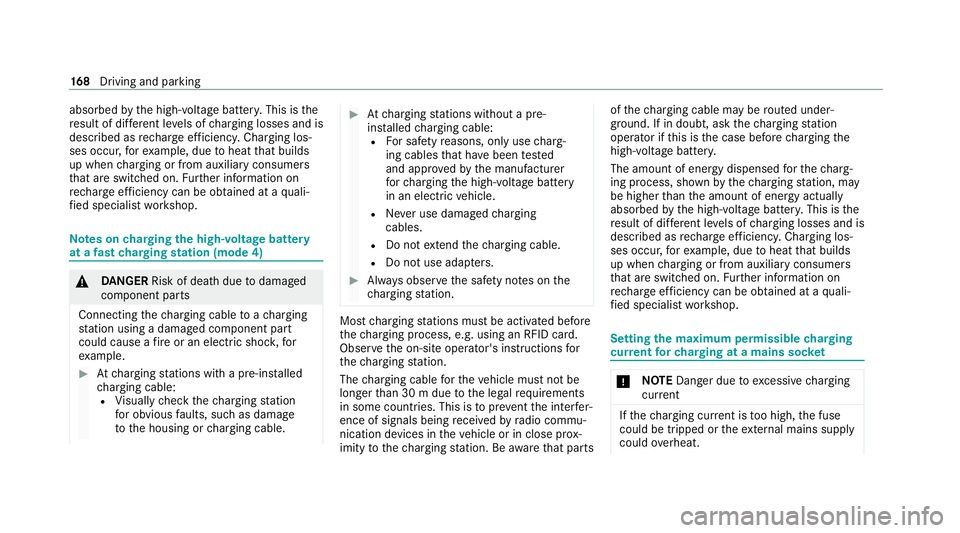
absorbed
bythe high-voltage batter y.This is the
re sult of dif fere nt le vels of charging losses and is
desc ribed as rech arge efficiency. Charging los‐
ses occu r,fo rex ample, due toheat that builds
up when charging or from auxiliary consume rs
th at are swit ched on. Further information on
re ch arge efficiency can be obtained at a quali‐
fi ed specialist workshop. Note
s oncharging the high-voltage bat tery
at a fast charging station (mode 4) &
DANG ER Risk of death due todamaged
component parts
Connecting thech arging cable toach arging
st ation using a damaged component part
could cause a fire or an electric shoc k,for
ex ample. #
Atcharging stations with a pre-ins talled
ch arging cable:
R Visually check thech arging station
fo r obvious faults, such as damage
to the housing or charging cable. #
Atcharging stations without a pre-
ins talled charging cable:
R For saf etyre asons, on lyuse charg‐
ing cables that ha vebeen tested
and appr oved bythe manufacturer
fo rch arging the high-voltage battery
in an electric vehicle.
R Never use dama gedch arging
cables.
R Do not extend thech arging cable.
R Do not use adap ters. #
Alw ays obser vethe saf ety no tes on the
ch arging station. Most
charging stations must be activated before
th ech arging process, e.g. using an RFID card.
Obse rveth e on-site operator's instructions for
th ech arging station.
The charging cable forth eve hicle must not be
longer than 30 m due tothe legal requ irements
in some countries. This is topreve ntthe inter fer‐
ence of signals being recei vedby radio commu‐
nication devices in theve hicle or in close pr ox‐
imity tothech arging station. Be aware that parts of
thech arging cable may be routed under‐
ground. If in doubt, ask thech arging station
operator if this is the case before charging the
high-voltage batter y.
The amount of energy dispensed forth ech arg‐
ing process, shown bythech arging station, may
be higher than the amount of energy actually
absorbed bythe high-voltage batter y.This is the
re sult of dif fere nt le vels of charging losses and is
desc ribed as rech arge efficiency. Charging los‐
ses occu r,fo rex ample, due toheat that builds
up when charging or from auxiliary consume rs
th at are swit ched on. Further information on
re ch arge efficiency can be obtained at a quali‐
fi ed specialist workshop. Setting
the maximum permissible charging
cur rent forch arging at a mains soc ket *
NO
TEDanger due toexcessive charging
cur rent If
th ech arging cur rent is too high, the fuse
could be tripped or theex tern al mains supply
could overheat. 16 8
Driving and pa rking
Page 172 of 453
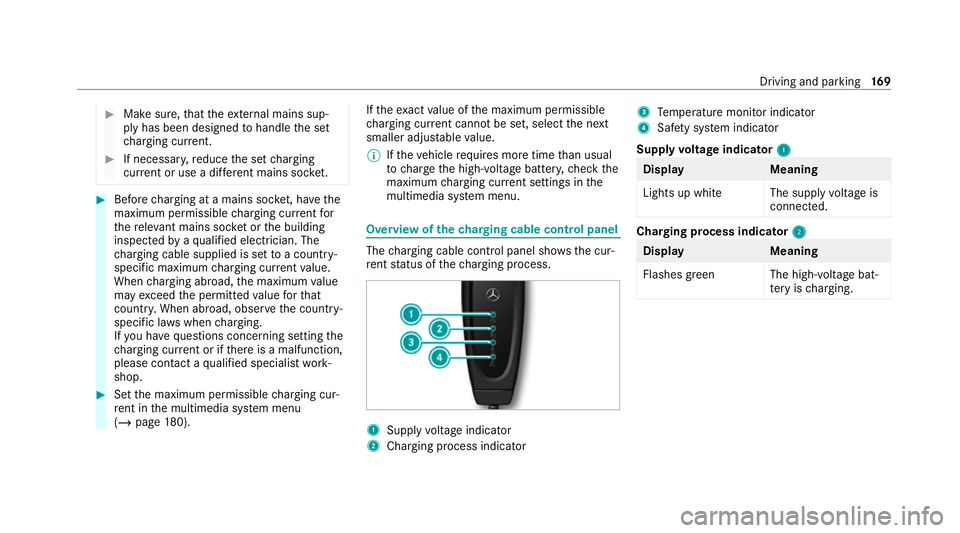
#
Make sure, that theex tern al mains sup‐
ply has been designed tohandle the set
ch arging cur rent. #
If necessa ry,re duce the set charging
cur rent or use a di fferent mains soc ket. #
Before charging at a mains soc ket, ha vethe
maximum permissible charging cur rent for
th ere leva nt mains soc ket or the building
inspected byaqu alified electrician. The
ch arging cable supplied is set toa countr y-
specific maximum charging cur rent value.
When charging abroad, the maximum value
may exceed the permitted value forth at
countr y.When abroad, obser vethe count ry-
specific la wswhen charging.
If yo u ha vequestions concerning setting the
ch arging cur rent or if there is a malfunction,
please conta ct aqualified specialist work‐
shop. #
Set the maximum permissible charging cur‐
re nt in the multimedia sy stem menu
(/ page 180). If
th eex act value of the maximum permissible
ch arging cur rent cannot be set, select the next
smaller adjus table value.
% Ifth eve hicle requ ires more time than usual
to charge the high-voltage batter y,ch eck the
maximum charging cur rent settings in the
multimedia sy stem menu. Overview of
thech arging cable control panel The
charging cable control panel sho wsthe cur‐
re nt status of thech arging process. 1
Supp lyvo ltage indicator
2 Charging process indicator 3
Temp erature monitor indicator
4 Safety sy stem indicator
Supp lyvo ltage indicator 1
1 Displa
yM eaning
Lights up whit eThe supplyvoltage is
connec ted. Charging process indicator
2
2 Displa
yM eaning
Flashes green The high- voltage bat‐
te ry isch arging. Driving and parking
16 9
Page 173 of 453
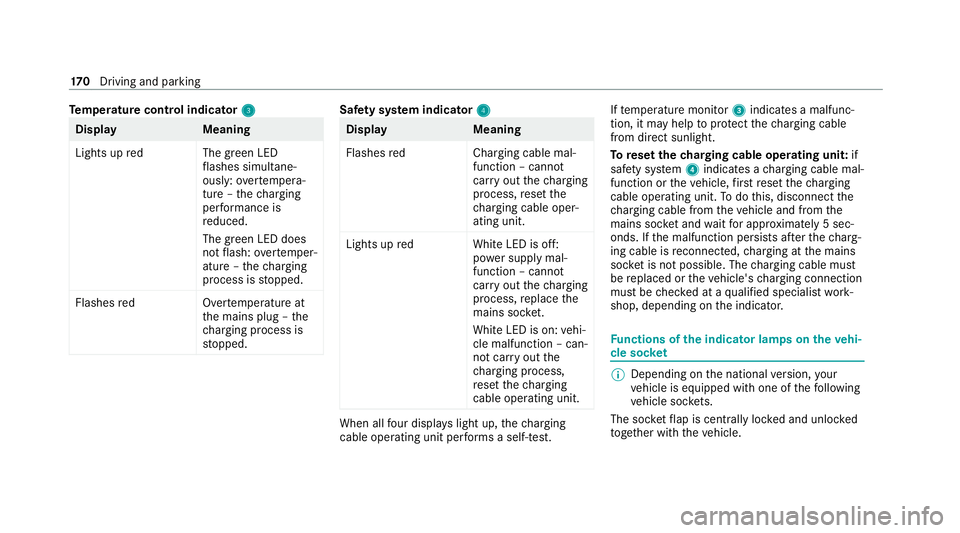
Te
mp erature control indica tor3
3 Displ
ay Meaning
Lights up redT he green LED
fl ashes simul tane‐
ously: overtemp era‐
ture – thech arging
per form ance is
re duced.
The green LED does
not flash: overtemp er‐
ature – thech arging
process is stopped.
Flashes redO vertemperature at
th e mains plug – the
ch arging process is
st opped. Saf
ety sy stem indica tor4 4 Displ
ay Meaning
Flashes redC harging cable mal‐
function – cannot
car ryout thech arging
process, reset the
ch arging cable oper‐
ating unit.
Lights up redW hite LED is off:
po we r supp lymal‐
function – cannot
car ryout thech arging
process, replace the
mains soc ket.
White LED is on: vehi‐
cle malfunction – can‐
not car ryout the
ch arging process,
re set thech arging
cable operating unit. When all
four displ ays light up, thech arging
cable operating unit per form s a self-test. If
te mp erature monitor 3indicates a malfunc‐
tion, it may help toprotect thech arging cable
from direct sunlight.
To reset thech arging cable operating unit: if
saf ety sy stem 4indicates a charging cable mal‐
function or theve hicle, firs tre set thech arging
cable operating unit. Todo this, disconnect the
ch arging cable from theve hicle and from the
mains soc ket and waitfor appro ximately 5 sec‐
onds. If the malfunction persists af terth ech arg‐
ing cable is reconnected, charging at the mains
soc ket is not possible. The charging cable must
be replaced or theve hicle's charging connection
must be checked at a qualified specialist work‐
shop, depending on the indicator. Fu
nctions of the indica tor lamps on the vehi‐
cle soc ket %
Depending on the national version, your
ve hicle is equipped with one of thefo llowing
ve hicle soc kets.
The soc ketflap is centrally loc ked and unloc ked
to ge ther with theve hicle. 17 0
Driving and pa rking
Page 174 of 453
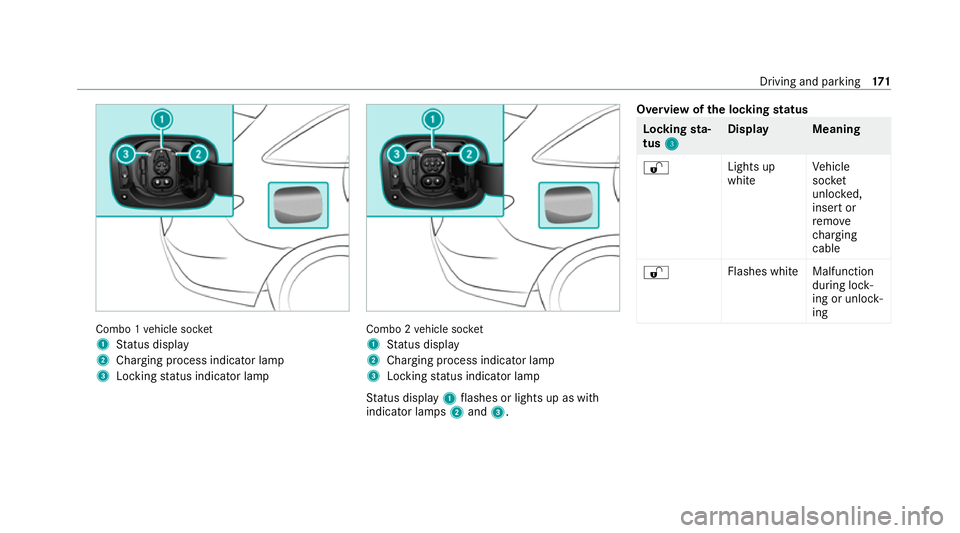
Combo 1
vehicle soc ket
1 Status display
2 Charging process indicator lamp
3 Locking status indicator lamp Combo 2
vehicle soc ket
1 Status display
2 Charging process indicator lamp
3 Locking status indicator lamp
St atus display 1flashes or lights up as with
indicator lamps 2and 3. Overview of
the locking status Lock
ingsta‐
tus 3 3 Displa
yM eaning
% Lights up
whiteVe
hicle
soc ket
unlo cked,
insert or
re mo ve
ch arging
cable
% Flashes whit
eMalfunction
during lock‐
ing or unlo ck‐
ing Driving and parking
171
Page 175 of 453
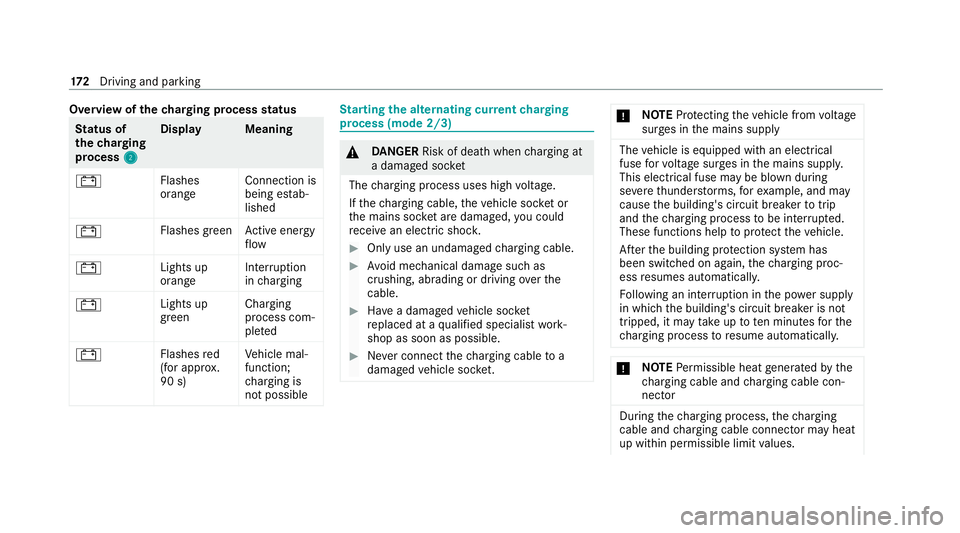
Overview of
thech arging process status St
atus of
th ech arging
process 2 2Displa
yM eaning
# Flashes
orangeConnection is
being es
tab‐
lished
# Flashes green
Active energy
fl ow
# Lights up
orangeInter
ruption
in charging
# Lights up
greenCharging
process com‐
ple
ted
# Flashes
red
(for appr ox.
90 s) Ve
hicle mal‐
function;
ch arging is
not possible St
arting the alternating cur rent charging
process (mode 2/3) &
DANG ER Risk of death when charging at
a damaged soc ket
The charging process uses high voltage.
If th ech arging cable, theve hicle soc ket or
th e mains soc ket are dama ged, you could
re cei vean electric shoc k. #
Only use an undamaged charging cable. #
Avoid mechanical damage such as
crushing, abrading or driving over the
cable. #
Have a damaged vehicle soc ket
re placed at a qualified specialist work‐
shop as soon as possible. #
Never connect thech arging cable to a
damaged vehicle soc ket. *
NO
TEProtecting theve hicle from voltage
sur ges in the mains supply The
vehicle is equipped with an electrical
fuse forvo ltage sur ges in the mains suppl y.
This electrical fuse may be blown during
se vere thunder storms, forex ample, and may
cause the building's circuit breaker totrip
and thech arging process tobe inter rupted.
These functions help toprotect theve hicle.
Af terth e building pr otection sy stem has
been switched on again, thech arging proc‐
ess resumes automatically.
Fo llowing an inter ruption in the po wer supp ly
in which the building's circuit breaker is not
tripped, it may take up to te n minu tesfo rthe
ch arging process toresume automatically. *
NO
TEPerm issible heat generated bythe
ch arging cable and charging cable con‐
nec tor During
thech arging process, thech arging
cable and charging cable connec tor may heat
up within permissible limit values. 17 2
Driving and pa rking
Page 176 of 453
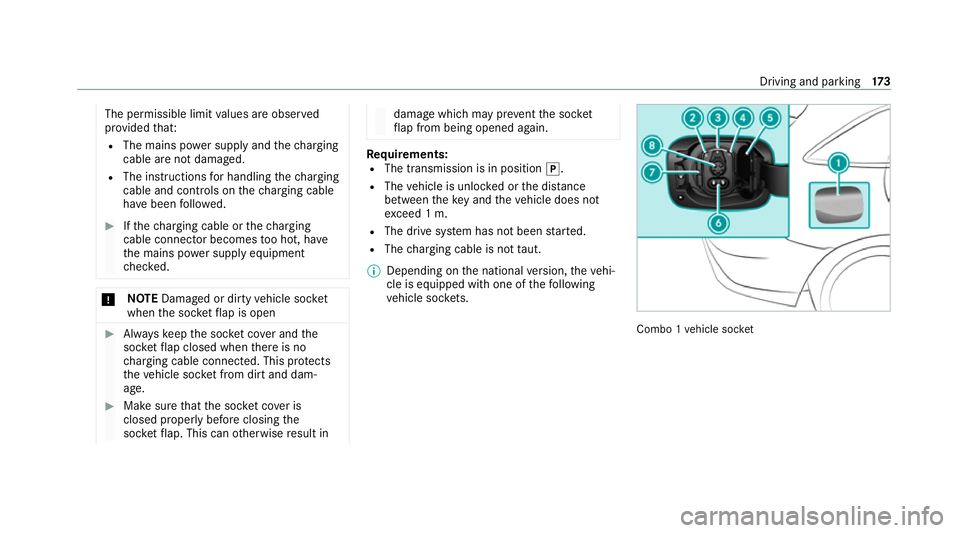
The permissible limit
values are obser ved
pr ov ided that:
R The mains po wer supply and thech arging
cable are not damaged.
R The instructions for handling thech arging
cable and controls on thech arging cable
ha ve been follo we d. #
Ifth ech arging cable or thech arging
cable connec tor becomes too hot, ha ve
th e mains po wer supp lyequipment
ch ecked. *
NO
TEDama ged or dirty vehicle soc ket
when the soc ketflap is open #
Alw ayske ep the soc ket co ver and the
soc ketflap closed when there is no
ch arging cable connec ted. This pr otects
th eve hicle soc ket from di rtand dam‐
age. #
Make sure that the soc ket co ver is
closed properly before closing the
soc ketflap. This can otherwise result in damage which may pr
eventthe soc ket
fl ap from being opened again. Re
quirements:
R The transmission is in position j.
R The vehicle is unloc ked or the dis tance
between theke y and theve hicle does not
ex ceed 1 m.
R The drive sy stem has not been star ted.
R The charging cable is not taut.
% Depending on the national version, theve hi‐
cle is equipped with one of thefo llowing
ve hicle soc kets. Combo 1
vehicle soc ket Driving and pa
rking 17 3
Page 177 of 453
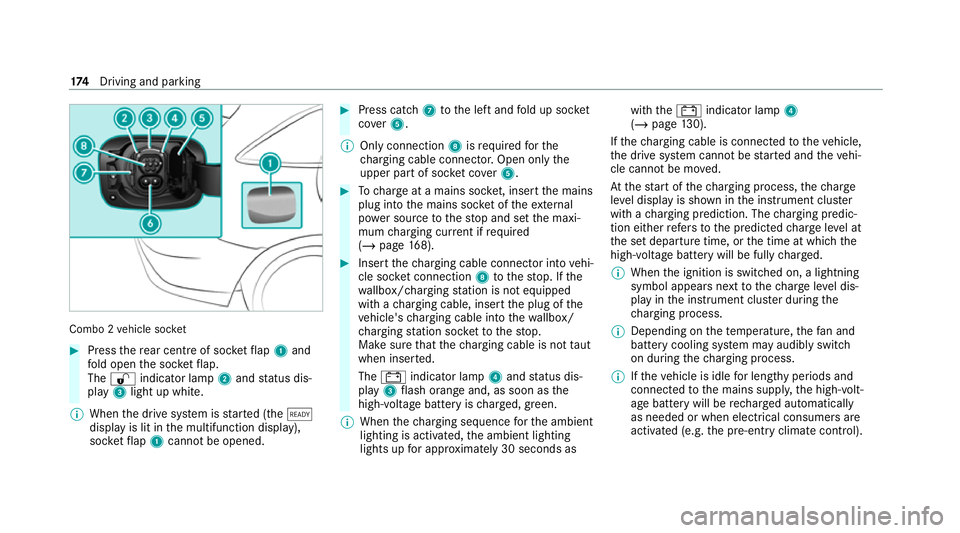
Combo 2
vehicle soc ket #
Press there ar centre of soc ketflap 1 and
fo ld open the soc ketflap.
The % indicator lamp 2and status dis‐
play 3light up white.
% When the drive sy stem is star ted (the õ
display is lit in the multifunction display),
soc ketflap 1 cannot be opened. #
Press cat ch7 tothe left and fold up soc ket
co ver5.
% Only connection 8isrequ ired forthe
ch arging cable connec tor.Open only the
upper part of soc ket co ver5. #
Tocharge at a mains soc ket, insert the mains
plug into the mains soc ket of theex tern al
po we r source tothestop and set the maxi‐
mum charging cur rent if requ ired
(/ page 168). #
Insert thech arging cable connec tor into vehi‐
cle soc ket connection 8tothestop. If the
wa llbox/ charging station is not equipped
with a charging cable, insert the plug of the
ve hicle's charging cable into thewa llbox/
ch arging station soc ketto thestop.
Make sure that thech arging cable is not taut
when inser ted.
The # indicator lamp 4and status dis‐
play 3flash orange and, as soon as the
high-voltage battery is charge d, green.
% When thech arging sequence forth e ambient
lighting is activated, the ambient lighting
lights up for appro ximately 30 seconds as with
the# indicator lamp 4
(/ page 130).
If th ech arging cable is connec tedto theve hicle,
th e drive sy stem cann otbe star ted and theve hi‐
cle cannot be mo ved.
At thest art of thech arging process, thech arge
le ve l display is shown in the instrument clus ter
with a charging prediction. The charging predic‐
tion either refers to the predicted charge leve l at
th e set departure time, or the time at which the
high-voltage battery will be fully charge d.
% When the ignition is switched on, a lightning
symbol appears next tothech arge leve l dis‐
play in the instrument clus ter during the
ch arging process.
% Depending on thete mp erature, thefa n and
battery cooling sy stem may audibly switch
on during thech arging process.
% Ifth eve hicle is idle for lengt hyperiods and
connec tedto the mains suppl y,the high-volt‐
age battery will be rech arge d automatically
as needed or when elect rical consumers are
acti vated (e.g. the pre-entry climate control). 174
Driving and pa rking
Page 178 of 453
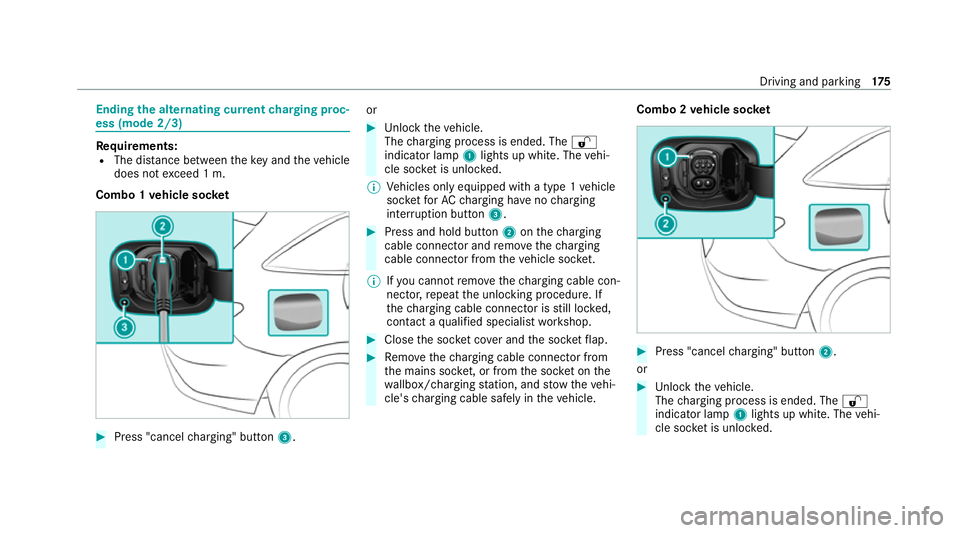
Ending
the alternating cur rent charging proc‐
ess (mode 2/3) Re
quirements:
R The dis tance between theke y and theve hicle
does not exceed 1 m.
Combo 1 vehicle soc ket #
Press "cancel charging" button 3. or #
Unlock theve hicle.
The charging process is ended. The %
indicator lamp 1lights up white. The vehi‐
cle soc ket is unloc ked.
% Vehicles only equipped with a type 1 vehicle
soc ketfo rAC charging ha veno charging
inter ruption button 3. #
Press and hold button 2onthech arging
cable connec tor and remo vethech arging
cable connec tor from theve hicle soc ket.
% Ifyo u cannot remo vethech arging cable con‐
nec tor,re peat the unlocking procedure. If
th ech arging cable connec tor is still loc ked,
con tact a qualified specialist workshop. #
Close the soc ket co ver and the soc ketflap. #
Remo vethech arging cable connec tor from
th e mains soc ket, or from the soc ket on the
wa llbox/ charging station, and stow theve hi‐
cle's charging cable safely in theve hicle. Combo 2
vehicle soc ket #
Press "cancel charging" button 2.
or #
Unlock theve hicle.
The charging process is ended. The %
indicator lamp 1lights up white. The vehi‐
cle soc ket is unloc ked. Driving and parking
175
Page 179 of 453
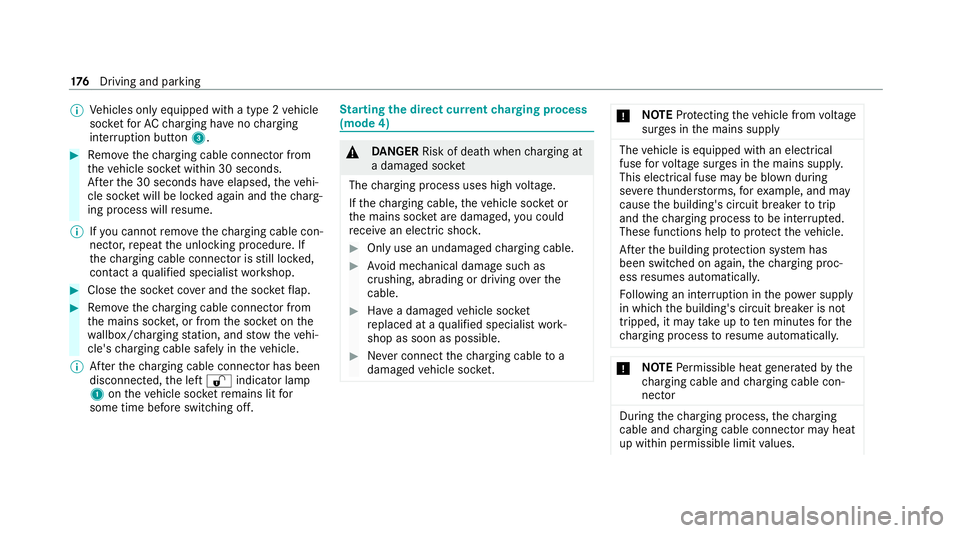
%
Vehicles only equipped with a type 2 vehicle
soc ketfo rAC charging ha veno charging
inter ruption button 3. #
Remo vethech arging cable connec tor from
th eve hicle soc ket wi thin 30 seconds.
Af terth e 30 seconds ha veelapsed, theve hi‐
cle soc ket will be lo cked again and thech arg‐
ing process will resume.
% Ifyo u cannot remo vethech arging cable con‐
nec tor,re peat the unlocking procedure. If
th ech arging cable connec tor is still loc ked,
con tact a qualified specialist workshop. #
Close the soc ket co ver and the soc ketflap. #
Remo vethech arging cable connec tor from
th e mains soc ket, or from the soc ket on the
wa llbox/ charging station, and stow theve hi‐
cle's charging cable safely in theve hicle.
% Afterth ech arging cable connec tor has been
disconnected, the left % indicator lamp
1 ontheve hicle soc ketre mains lit for
some time before switching off. St
arting the direct cur rent charging process
(mode 4) &
DANG ER Risk of death when charging at
a damaged soc ket
The charging process uses high voltage.
If th ech arging cable, theve hicle soc ket or
th e mains soc ket are dama ged, you could
re cei vean electric shoc k. #
Only use an undamaged charging cable. #
Avoid mechanical damage such as
crushing, abrading or driving over the
cable. #
Have a damaged vehicle soc ket
re placed at a qualified specialist work‐
shop as soon as possible. #
Never connect thech arging cable to a
damaged vehicle soc ket. *
NO
TEProtecting theve hicle from voltage
sur ges in the mains supply The
vehicle is equipped with an electrical
fuse forvo ltage sur ges in the mains suppl y.
This electrical fuse may be blown during
se vere thunder storms, forex ample, and may
cause the building's circuit breaker totrip
and thech arging process tobe inter rupted.
These functions help toprotect theve hicle.
Af terth e building pr otection sy stem has
been switched on again, thech arging proc‐
ess resumes automatically.
Fo llowing an inter ruption in the po wer supp ly
in which the building's circuit breaker is not
tripped, it may take up to te n minu tesfo rthe
ch arging process toresume automatically. *
NO
TEPerm issible heat generated bythe
ch arging cable and charging cable con‐
nec tor During
thech arging process, thech arging
cable and charging cable connec tor may heat
up within permissible limit values. 176
Driving and pa rking
Page 180 of 453
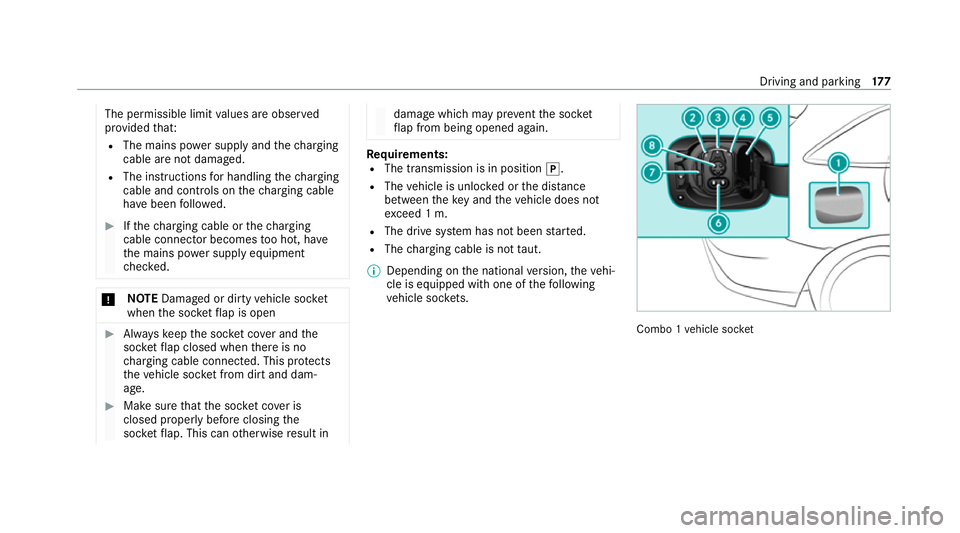
The permissible limit
values are obser ved
pr ov ided that:
R The mains po wer supply and thech arging
cable are not damaged.
R The instructions for handling thech arging
cable and controls on thech arging cable
ha ve been follo we d. #
Ifth ech arging cable or thech arging
cable connec tor becomes too hot, ha ve
th e mains po wer supp lyequipment
ch ecked. *
NO
TEDama ged or dirty vehicle soc ket
when the soc ketflap is open #
Alw ayske ep the soc ket co ver and the
soc ketflap closed when there is no
ch arging cable connec ted. This pr otects
th eve hicle soc ket from di rtand dam‐
age. #
Make sure that the soc ket co ver is
closed properly before closing the
soc ketflap. This can otherwise result in damage which may pr
eventthe soc ket
fl ap from being opened again. Re
quirements:
R The transmission is in position j.
R The vehicle is unloc ked or the dis tance
between theke y and theve hicle does not
ex ceed 1 m.
R The drive sy stem has not been star ted.
R The charging cable is not taut.
% Depending on the national version, theve hi‐
cle is equipped with one of thefo llowing
ve hicle soc kets. Combo 1
vehicle soc ket Driving and pa
rking 17 7